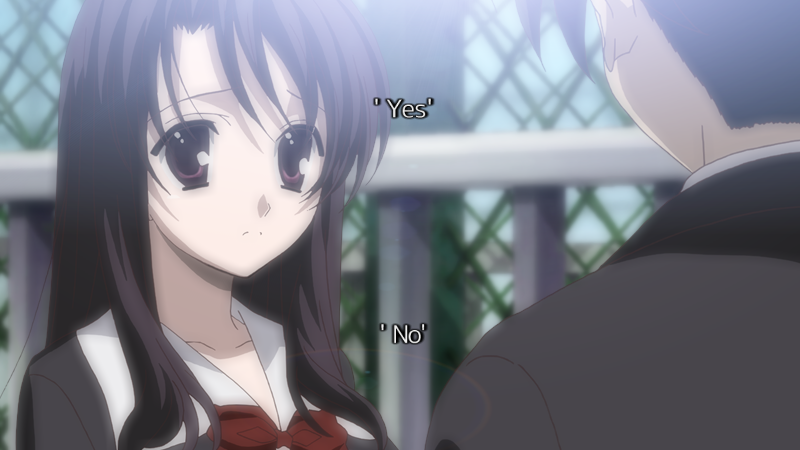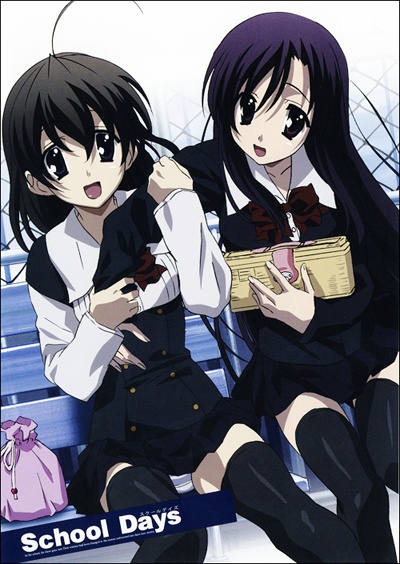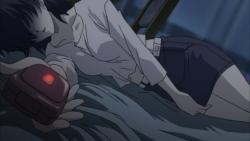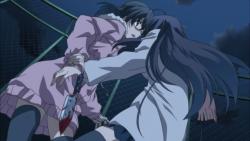school days все персонажи
School Days
“In school life, three persons were always together. Our relation was broken on that day. The past never recover no longer.” ——The episode tagline in the original version.
“In the school, three guys met. Their relation had been changed in the seasons, and turned into three love stories.” ——The episode tagline in the HQ version.
0verflow (Windows)
AiCherry (DVD)
guyzware, Regista (PS2)
ixia (PSP)
0verflow (Windows)
AiCherry (DVD)
Interchannel (PS2)
PalaceGame (PSP)
April 28, 2005 (JP)
October 8, 2010 (HQ) (JP)
June 27, 2012 (HQ) (NA)
Manga Original Run
May 26, 2006 – September 26, 2007
Anime Original Run
July 3, 2007 – September 27, 2007
School Days (スクールデイズ Sukūru Deizu) is an adult Japanese Visual Novel developed by 0verflow, released on April 28, 2005, and later ported for the PlayStation 2 (PS2) and PlayStation Portable (PSP). The story follows the life of Makoto Itou and his relationship with Sekai Saionji and Kotonoha Katsura which can develop differently depending on the player’s actions. The game requires very little interaction from the player, the player is only required to make changes on Makato’s behalf to change the course of the story. The game concludes with an ending based on the player’s choices, some of which became notorious for their graphic violence.
The game ranked as the best-selling visual novel in Japan for the time of its release, continuing to chart in the national top 50 for nearly five months afterward. School Days has received a spin-off of the original story called Summer Days, a parallel story called Cross Days and an another spin-off called Island Days, has been developed by Klonfor the Nintendo 3DS. School Days was remastered as School Days HQ on October 8, 2010 and localized in North America on June 27, 2012.
Following the game’s release, School Days made several transitions into other media. The original story was adapted into a manga and serialized in the Kadokawa Shoten magazine Comp Ace; it was later published into two volumes. Comic anthologies, light novels and art books were also published, as were audio dramas and several albums of music.
An animated television series, two direct-to-video (OVA) single releases, and a concert film were also produced, the first of which became a precursor for an internet meme when its finale was pulled from broadcast.
Contents
Gameplay
An example of a choice in the game, The player can choose either, or decline to answer
As a visual novel, School Days requires extremely minimal gameplay. At predetermined intervals the game presents the player with one or two choices to make, or the player can choose to not make a choice. These choices change the course of the story and Makoto’s relationship bar with the main heroines can increase.
The game contains many routes that conclude with a specific ending. Not all routes are unique since some endings can be achieved through many different routes and not all routes have to be explored to reach every ending. This means if the player wants to see everything the game has the player would have to play through the game numerous times, beyond reaching every possible ending. The endings in particular will usually see either Makoto end up with Kotonoha, Sekai, Hikari, or Otome depending on the route they take or will end in either the death of Kotonoha, Sekai, or even Makoto himself.
Unlike traditional visual novels that consist of the protagonist talking to static images of characters, School days is unusual in that it incorporates motion and voice, making it similiar to an anime series. The game is broken down into 6 episodes and the episodes are then seperated in parts. The player is initially given the ability to pause, skip to the next part, return to the beginning of the current part and return to the beginning of a previous part. The player can also turn on the ability to skip to the next choice, although if the player hasn’t viewed a specific part the player will be stopped at those. After the player has viewed a specific part the abliity to fast forward becomes available. Progress can be saved at anytime in up to 100 slots.
School Days focuses on the life of Makoto Itou, living with his divorced and unseen (but heard) mother in the fictional city of Haramihama. During his second term, he begins to take notice of Kotonoha Katsura, who takes the same train as him. After the rearrangement of his homeroom seating, he’s acquainted with Sekai Saionji. It is after Sekai plays matchmaker for him and Kotonoha that his life begins to change. Sekai befriends the two and provides them with a private spot to meet and have lunch. Despite her triumphant efforts, Sekai develops her own feelings for Makoto and kisses him at a train station.
Over the course of his relationship with Kotonoha and Sekai, Makoto is acquainted with a handful of other people, including Setsuna Kiyoura, a habitually reserved member of the student council and Sekai’s lifelong friend, as well as Hikari and Nanami, Sekai and Setsuna’s friends.
Of the people Makoto knows, two other friends make frequent appearances. The first is Taisuke Sawanaga, Makoto’s eccentric best friend, and Otome Katou, a former middle school classmate.
Many characters from 0verflow’s previous visual novels either appear or are mentioned since School Days takes place in the same universe.
Development
School Days was 0verflow’s tenth game to develop. News of School Days first surfaced on October 5, 2004 when 0verflow posted a link to the game’s then-live website and development log on their official site. In the blog, 0verflow revealed that School Days had been in pre-production for roughly two years and would be a fully animated game. Updates on the development of the game were scheduled for Tuesdays and Fridays, and the company encouraged fans to attend Dream Party 2004, an upcoming anime convention at Tokyo Big Sight in Ariake, on October 11, where it would make its first public showcase of the game and characters. A follow-up of the venue was made on October 15. Toward the end of the month on October 26, 0verflow posted that new information about School Days would be circulated in the November issue of Tech Gian, an adult magazine published by Enterbrain.
Promotion for the game began shortly after. In a November 6 development post, 0verflow announced that it was planning a public screening of new game material, but was experiencing difficulty acquiring space for it. The company had initially chosen to have the venue in Akihabara but was unable to find a retailer willing to host it, prompting a visit to Osaka the following week. News that the game would contain music by artists such as Minami Kuribayashi, Haruko Momoi, Yozuca* and YURIA was posted on November 30, along with a release date change to February 25, 2005.
On December 28, 2004, 0verflow released a public trial of School Days and announced that the company would be attending Comiket 67 at Tokyo Big Sight from December 29 to 30, handing out phonecards to the first 50 visitors to their booth. Two months later, on February 2, 2005, the company announced that the game had been postponed again to April 28. From April 5 to April 8, 0verflow concluded their development log with comments from Soyogi Tōno, Kaname Yuzuki, Tatsuya Hirai, Yuki Matsunaga, Hikaru Isshiki and Hana Yamamoto, the respective voices of Kotonoha, Sekai, Makoto, Otome, Hikari and Setsuna. To address bugs that were later found in the game, 0verflow released a patch to bring School Days to a stable build of 1.11. On June 26, 2007, 0verflow and Lantis-net radio began to air an internet radio drama called «Radio School Days». Broadcasts finished up March 28, 2008 with 39 episodes aired.
On April 21, 2011, 0verflow announced via their blog that support for School Days was being discontinued.
Release History
School Days was ported to three other platforms. The first of these was by AiCherry, an interactive movie developer, who announced on August 20, 2007 that it had picked up the game for development, releasing it as a four disc DVD game on September 28. That same year, on August 31, Interchannel posted a link on their blog to the official website of School Days L×H, a PlayStation 2 (PS2) port in development by Guyzware, that would be edited of explicit sexual content. The game was released on January 17, 2008 and assessed by the Computer Entertainment Rating Organization (CERO), Japan’s primary video game content rating system, receiving a 15-years-or-older «C» rating for sexual themes and profanity. The third and final port was developed by PalaceGame for the PlayStation Portable (PSP). After postponing the game on May 11, it was released as four UMDs on June 30, 2010.
0verflow opened what would become the homepage for School Days HQ on May 21, 2010, a remastering of the original game initially scheduled for release in August. The site was finished June 3, and on July 16, the game was postponed to September 24. A trial was publicly released for download on August 7, and from August 20 to September 28, 0verflow promoted the game. Customers who had purchased the original School Days would be given the opportunity to upgrade to HQ for a fee until October 11, by either mailing in their game disc or visiting stores in Akihabara, Osaka or Nagoya. Distributors offered collectable phonecards for reservations, and after a second date change on September 10, the game was released October 8.
On March 3, 2011, 0verflow acknowledged Sekai Project, an unofficial fan translation group, who had reportedly begun localizing School Days in April 2006. Partnering with American distributor JAST USA, School Days HQ, uncensored in English, was announced for a North American release on March 11, 2011. Development instead continued into 2012, and on May 18, JAST announced that the company had begun taking pre-orders for the Collector’s Edition, a bundled release of the game packaged with a keychain and mousepad. The company announced weeks later on June 1 that School Days HQ had gone gold. Following news on June 26 that the company would exhibit the game at Anime Expo 2012, JAST made an update to the June 1 announcement that School Days HQ had begun shipping. The downloadable version of the game was later released on August 6.
Media
Related Visual Novels
0verflow developed several visual novels related to School Days, sharing the game universe. These games include Large PonPon, PureMail, Pleasure Box, Snow Radish Vacation, Summer Radish Vacation, Summer Radish Vacation 2, Miss Each Other. Further games released after School Days include a spin-off called Summer Days, a parallel story called Cross Days.
Manga
Based on the story of the original game, School Days was reimagined as a manga, illustrated by Homare Sakazuki and serialized in the Kadokawa Shoten magazine Comp Ace from May 26, 2006 to September 26, 2007. On July 12, 2007, 0verflow announced that the manga had been collected into its first volume, comprising five chapters set to be released on July 26. Later that year, the second and final volume, comprising the remaining seven chapters, was released on November 26.
Various artists also produced short manga of School Days that were compiled into two comic anthologies. The «School Days Comic Anthology» was released by Ohzora Publishing on October 25, 2005 under their P-mate Comics imprint, containing nine short manga by individual artists. On February 25, 2008, Ichijinsha printed the «School Days Kotonoha Anthology» under their DNA Media Comics imprint, a collection of manga primarily featuring the character Kotonoha Katsura.
Books and publications
In addition to the manga, School Days was adapted into other print media. The first of these was the «School Days Visual Guide Book» published by Jive on September 16, 2005, an artbook of character illustrations, model sheets, screenplay, storyboards and a visual hierarchy of the choices and corresponding scenes in the game. Separate editions for the anime television series and Playstation 2 game were also published, on December 1, 2007 and March 21, 2008, respectively. Collections of production work from the Windows game such as character and environment art, screenplay, artist commentaries and all manufactured promotional items were collected in the «School Days Official Visual Art Works» (School Days 公式ビジュアル・アートワークス School Days Koushiki Bijuaru Atowa Kusu?) on December 16, 2005 and also featured in the «SummerDays [sic] & School Days Visual Collection» on August 31, 2006.
The first of four light novels, all illustrated by Junji Goto, was written by Ryuna Okada and printed by Harvest Publishing under their Harvest Novels imprint. Released on December 1, 2005, «School Days: Sekai Hen» (School Days 世界編) retells the original story from the perspective of Sekai. Okada would follow up the book with «School Days: Kotonoha Hen» (School Days 言葉編) on January 1, 2006, switching to the perspective of Kotonoha. Two light novels were also published by Jive, the first of which was written by Takuya Baba, «School Days: Kimi to Iru, Sora» (School Days 君といる、空) and printed on December 16, 2005, and a second by Hiro Akiduki, «School Days: Innocent Blue», released on April 28.
Anime
School days was adapted into a twelve-episode anime television series by TNK. The series ran from July 3, 2007 to September 27, 2007. TNK also produced two direct-to-video (OVA) episodes of School Days. The first, titled «Valentine Days», was bundled with limited edition copies of School Days L×H, and features an unrelated comedic romp through Valentine’s Day as Kotonoha, Sekai, and Otome try and give Makoto giri chocos. The second, «Magical Heart Kokoro-chan», jaunts the series into magical girl territory, portraying Kokoro Katsura as the superheroine Magical Heart; it was released on March 26, 2008.
Official Continuity and Sequels
Since after School Days was released there hasn’t been any direct sequels, only a spin-off called Summer Days (which was remade into Shiny Days), a parallel story called Cross Days and another spin-off called Island Days the official continuity hasn’t been revealed but the official family tree shows us that Makoto has children with Sekai and Setsuna. Since Summer/Shiny Days is a spin-off it has its own continuity.
School Days
In School Days’ continuity the only ending that fits the family tree is Bavarois with I’m His Wife. Besides the many endings that involve Makoto impregnating Sekai this ending is the only one where Makoto impregnates Setsuna and keeps a relationship with Sekai all the way to summer. Sekai isn’t pregnant yet but that doesn’t rule out the possibility. However previous games have a history of either continuing from endings that didn’t exist or combining elements of multiple endings. It’s still unknown what the official continuity is.
Summer/Shiny Days
The above family tree was released before the release of Summer/Shiny Days so it possibly doesn’t apply to this continuity. If it does, however, the ending Paris for Four is the one that applies since it’s the only ending that involve Makoto impregnating Sekai and Setsuna. Makoto also impregnates Mai and Youko but the family tree doesn’t show it so it might be invalid.
Strip Battle Days
This game presents a different possible continuity that is essentially amalgamation of Sleep With the Entire Katsura Family Project and Rain of Carnage endings from Shiny Days. In this continuity Makoto is in relationship with all female Katsuras (like in first mentioned ending) but in more ominous way. Effectively cheating them with each other, and even periodically raping Kokoro. Eventually Makoto ends impregnating Manami and Kotonoha, while Kokoro turns into silent reserved girl, that is just shadow of her former self. Due to meta nature of this game, it is however hard to tell whether this continuity can be taken as official.
Videos
SCHOOL DAYS HQ ( Still I Love You
Mitsumeru Yori Wa Shiawase
Trivia
Prior to this game being released in 2005 there were 2 previous visual novels which also had the name School Days:
The episode tagline in the original version is different from the HQ version.
School days все персонажи
Ответы на эти и другие вопросы даст представленный сериал о буднях обычных японских школьников. В нем не будет спасения мира, зато будут простые истины, которые пригодятся каждому «обдумывающему житье».
|
| Герои аниме |
|
|
| все персонажи |
| Эпизоды |
| # | эпизод | сценарий | раскадровка | режиссёр эпизода | анимация |
| 1. | Confession 04.07.2007, 25 мин. | Уэдзу Макото | Мотонага Кэйтаро | Мотонага Кэйтаро | Гото Дзюндзи |
| 2. | Their Distance 11.07.2007, 25 мин. | Хигураси Тябо | Кодэра Кацуюки | Китахата Тору | И Чон Квон |
| 3. | Passing Thoughts 18.07.2007, 25 мин. | Акидзуки Хиро | Амия Масакадзу | Амия Масакадзу | Накадзима Ёсико |
| 4. | Purity 25.07.2007, 25 мин. | Нада Ютака | Канадзава Кацума | Симидзу Кадзунобу | Мураяма Косукэ |
| 5. | Waves 01.08.2007, 25 мин. | Хигураси Тябо Уэдзу Макото | Кубо Таро | Кубо Таро | Симидзу Кацухиро |
| 6. | A Revealed Relationship 08.08.2007, 25 мин. | Акидзуки Хиро | Танака Хиронори | Ёцудзи Такао | Танака Мотоки |
| 7. | Festival Eve 15.08.2007, 25 мин. | Акидзуки Хиро | Сокудза Макото | Сокудза Макото | Такэкоси Мицухо |
| 8. | School Festival 22.08.2007, 25 мин. | Нада Ютака | Кодэра Кацуюки | Ёсида Сюндзи | Утихара Сигэру |
| 9. | After Evening Festival 29.08.2007, 25 мин. | Нада Ютака Уэдзу Макото | Накамура Нориюки | Амия Масакадзу | Накадзима Ёсико |
| 10. | Mind and Body 05.09.2007, 25 мин. | Акидзуки Хиро Уэдзу Макото | Ватанабэ Тэцуя | Ватанабэ Тэцуя | И Чон Квон |
| 11. | Everybody`s Makoto 12.09.2007, 25 мин. | Акидзуки Хиро Уэдзу Макото | Канадзава Кацума | Симидзу Кадзунобу | Мураками Маки Хаттори Кэндзи |
| 12. | School Days 27.09.2007, 25 мин. | Акидзуки Хиро Уэдзу Макото | Мотонага Кэйтаро | Мотонага Кэйтаро | Гото Дзюндзи Танака Мотоки |
Удивительное дело — прочитав под полторы сотни комментариев, начинает казаться, что смотрели SD в основном кто? Девушки и парни-подростки. Нет, не только конечно, но в большей своей части.
А потому я буду не столько говорить о самом сюжете или героях, а о суровой правде жизни.
Это именно он — каждый из нас. Конечно, немножко доведённый, без задней мысли, конечно, до абсолюта, но ужасно похожий. Наверное именно поэтому на него так больно смотреть — узнаёшь себя. И можно «честно» говорить, что мол, виноваты родители, оставившие его одного, виновата Секай, виновато окружение. Но всё же он черезвычайно узнаваем — пойдите в любую школу и в восьмом-десятом классе вы обнаружите сотни таких макото-кунов. Чуть более реальных, слегка приправленных российской действительностью — но всё одно почти таких же, как в SD.
Надо честно сказать и ещё одно — в наших условиях всё проще. Если вы увидели в жизни макото-куна, не сдерживайтесь — дайте ему в морду, как он того заслуживает — это чертовски действенное лекарство. Вот серьёзно — если бы серии в шестой-седьмой-восьмой кто-нибудь чуть более сознательный заехал нашему макото-куну в репу по самое не желаю — мы бы сейчас не разливались в словоблудии, потому что всё бы закончилось прилично.
А так мы посмотрели отличную сагу о безответственности. До конца раскрывающую тему. Здесь обычная школа и обычные школьницы, у которых просто всё впервые и поэтому доходит до последних крайностей. Приправленная обычным макото-куном и массовым отсутствием всех и всяческих родителей, воспитателей, учителей и друзей. Чертовски реально и знакомо. Дьявольски больно — потому что на это месте могли бы оказаться и мы.
| +228 |  | Если Вы считаете этот комментарий полезным, то проголосуйте за него. |
| +67 |  | Если Вы считаете этот комментарий полезным, то проголосуйте за него. |
Сэкай? Девочка, по своей воле практически повторившая путь Мицке из Kimi ga Nozomu Eien? Пожалуй, нет. Она была обречена с самого начала, с того момента, как села за парту к нашему «герою».
Посмотрел, называется, в кои-то веки простенький гаремник.
| +64 |  | Если Вы считаете этот комментарий полезным, то проголосуйте за него. |
Мда, товарищи командиры. Всё бы так кончалось. Вы спрашиваете, как размножаются ёжики? Ёжики размножаются с трудом!
| +38 |  | Если Вы считаете этот комментарий полезным, то проголосуйте за него. |
ОСТОРОЖНО, СПОЙЛЕРЫ!
Хм.
Аниме занятное, по-другому не скажешь. Есть над чем порассуждать.
b>Осторожно, далее идут спойлеры./b>
Как я думал при просмотре? А вот как:
Сначала нам представляют стандартное love аниме.
Затем, гг говорит, что девушка ему наскучила, в чём я совершенно с ним согласен, особенно когда она говорила, про лошадей и Европу.
Он переходит на Сэкай, в чём я разумеется его поддерживал. Эта девушка очень походит быть его идеалом.
В принципе стандартный сюжет, на этом можно было бы и закончить.
Когда я видел, что у гг есть девушка, которую он любит, события вроде как стали разворачиваться в ту сторону, что порвать-то с предыдущей надо. И давно надо. Но гг не спешит.
В итоге к гг лезут другие девушки, и со всеми он начинает заниматься сексом, что выглядит нелогично, и даже местами смешно. Слишком уж не реально это всё. Слишком много и слишком просто. Такого не бывает. (Но логика на самом деле есть, читаем далее).
Ближе к концу отчётливо видно, что Сэкай приравнивается к Котонохе, только первая из-за того, что была недотрога надоела за 2 серии, а вторая за 6.
Конец выглядит как раз-таки логичным. И объясняет почти всё.
Надеюсь читать было не скучно, и хотя бы некоторые осилят эту кучу букв.
| +32 |  | Если Вы считаете этот комментарий полезным, то проголосуйте за него. |
ОСТОРОЖНО, СПОЙЛЕРЫ!
Смотрел анимэ дважды, второй раз после того, как поиграл в визуальный роман, и ощущения были совершенно противоположными.
Когда смотрел впервые, согласился бы с огромным количеством здешних комментариев в том, что «герои размыты», а «Котоноху жалко». Однако после того, как насладился визуальным романом и посмотрел во второй раз анимэ, я в полной мере ощутил то, что, должно быть, ощущал по отношению к Котонохе главный герой.
Поэтому я не могу согласиться с тем, что Макото был настолько «стеснительным», что не мог даже заговорить с Котонохой. На протяжении всего анимэ очевидно, что Макото никаким стеснительным ни в коем случае не был. Просто-напросто человеку присуще чувство самосохранения: вот и Макото чувствовал, что хоть Котоноха и нравилась ему внешне, она слишком отличалась от него и всех, кого он когда-либо знал, а значит отношения с ней потребуют значительных эмоциональных затрат. К ним же пофигист Макото был совершенно не готов.
Что же собственно ощущал по отношению к Котонохе Макото? Ему попросту было с ней крайне неудобно. Рядом с ней Макото необходимо было постоянно себя контролировать, причем не столько в том, чтобы не «распускать руки», хотя и это тоже, но и в том, что он мог говорить, а чего нет. Если учитывать, что прежде чем Макото изменил Котонохе с Сэкаи, прошел как минимум месяц (тогда как раз похолодало, и они не могли больше есть на крыше; неизвестно, в какой провинции Японии происходит действие, но в любом случае от начала семестра до такого похолодания времени должно было пройти скорей всего не меньше месяца), можно представить, как чувствовал себя Макото, говоря: «Я думал, встречаться будет весело. Но мне было намного веселее просто дурачиться с Сэкаи за ланчем.».
Поэтому утверждение, что Макото руководила лишь «ширинка», когда он признавался в любви Сэкаи, очень предвзято. Было б так, он бы не упустил шанса воспользоваться для тех же целей и Котонохой, когда она уже была в неадекватном состоянии и готова была сделать все, что угодно, чтоб вернуть все «на круги своя». Но в Сэкаи он нашел в первую очередь ту легкость и непринужденность, которой ему не хватало с Котонохой, которая была свойственна и ему самому. А искусственность Котонохи не прошла, даже когда она была готова сделать для Макото все, что угодно.
Напоследок: где-то в комментариях я видел недовольство тем, что персонажи довольно «размыты», как будто бы плохо проработаны. Действительно персонажы как будто специально несколько размазаны, нет в них каких-то очень выделяющихся характеристик, и т.д., и т.п. Но именно благодаря этому и достигается это ощущение реалистичности. Лишенные каких-то ярко выделяющихся особенностей старшеклассники выглядят как-то более правдоподобно, чем если бы каждый из них был бы достоен отдельного многотомного описания его необычностей!
| +25 |  | Если Вы считаете этот комментарий полезным, то проголосуйте за него. |
Спокойно. Без паники. Я же сильная женщина
(с) А. Соловьев, В. Антонов. Аутотренинг.
И специально для меня придумали вот что:
Может, нас все-таки окружают живые люди и мы несколько увлеклись симуляторами отношений? Вероятно, именно таким вопросом задаются авторы, когда придумывают «реалистично плохую» концовку для романтического действа. Ой, нет-нет, погодите, не таким, не таким! Скорее, они просто предполагают, что, ну, если вдруг такое случиться, что мы, может быть, забудем о том, что игры отличаются от реальности, то, может быть, нужно будет подумать о том, что, может быть, нас все-таки окружают живые люди… Правда ведь, авторы ведь совсем ведь не психи, чтобы всерьез обвинять игроков в подобной бесчувственности, нэ? Они просто рассуждали, что если бы да кабы, то вот на этот случай, на всякий, на пожарный… черная комедия (чтобы никого всерьез не испугать, авторы ведь не психи, да?) как предупреждение, что ли…
И последнее. Конечно же, у всех должно хватить соображения на то, чтобы понять: я тут так весело все расписала не потому, что вышеозначенное аниме – комедия. Это просто прием такой, да. А в реальной жизни не бывает так, чтобы ходишь, обжимаешься с каждой встречной-поперечной, и ни одна тебе, образно выражаясь, за это сковородкой по башке не дала. И аниме как раз о том, что бывает, когда в реальной жизни ходишь и обжимаешься. Это же драма! О какой комедии может идти речь?! И подобное, разумеется, настолько очевидно, что вообще непонятно, зачем я об этом заговорила. Но, ладно уж, пусть будет, мне не жалко.
Долой
безобразников
по женской линии!
Парней-жеребцов
зажмем в дисциплине!
(с) Владимир Маяковский. Лозунг.
| +23 |  | Если Вы считаете этот комментарий полезным, то проголосуйте за него. |
ВОЗМОЖНЫ СПОЙЛЕРЫ!
I am continuing. …
10/10 За то, что вспомнил много интересного из своей жизни.
| +23 |  | Если Вы считаете этот комментарий полезным, то проголосуйте за него. |
Тем не менее, я хоть и чувствую симпатию к Котонохе, но не понимаю ее в одном: даже если бы все решилось более менее спокойно, то как бы она удерживала Ито, человека, который склонен «ходить налево», рядом с собой дальше. Я уж не говорю о том, как она вообще на него не плюнула после всего произошедшего (ну тут, как говориться, «сердцу не прикажешь»). Но как бы она его удерживала дальше? Сомневаюсь, что изображая из себя «служанку» Ито остался бы ей верен. С другой стороны, она была единственной, как я и говорил, кто смог заставить Ито хоть чуть чуть задуматься. Этот и еще тот факт, что она серьезно эволюционировала из девочки, которая знала о любви только истории из любовных романов, в жесткую рассудительную личность, оставляет надежду на то, что она способна воспитать «ребенка» Ито и записать в его голову «что такое хорошо и что такое плохо». Вообще, будь я на месте Ито, то не отпускал бы Котоноху с самого начала. Пусть она не знала, что ей надо. Пусть не была готова удовлетворить мужские сексуальные потребности. Пусть. Пусть. Пусть. Но с самого начала было видно, что она стремиться понять, что ей надо. А раз есть стремление, значит она этого добьется рано или поздно. Ей просто нужно было время и понимание со стороны Ито. Как бы там ни было, Котоноха единственный персонаж «Школьных дней», который до последнего оставался ЧЕЛОВЕКОМ, конечно не без изъянов, но тем не менее. Она боролась, она развивалась и оказалась самой сильной личностью. И какая бы ни была концовка в аниме (даже если тупо все бы разбежались друг от друга и про все забыли), она бы все равно вышла победителем именно по этой причине.
Всем спасибо! Приятного просмотра!
| +21 |  | Если Вы считаете этот комментарий полезным, то проголосуйте за него. |
Еще немного полезной информации. (Для отображения иероглифов на компьютере необходима поддержка восточных языков! )
Имена у героев нарицательные:
Секай – (世界 sekai せかい) – мир, вселенная, общество.
Макото – (誠 makoto まこと, ) – правда, истина, искренность, откровенность.
Сецуна – (刹那 setsuna せつな) – момент, мгновение, соединение, связующее звено, объединяющий фактор.
Котоноха – (言葉 kotoba ことば) – слово, язык, речь (это современное прочтение этих иероглифов в прямом их значении). Kotonoha ことのは, – устаревшее прочтение тех же иероглифов, сейчас применяется только для записи имени.


















